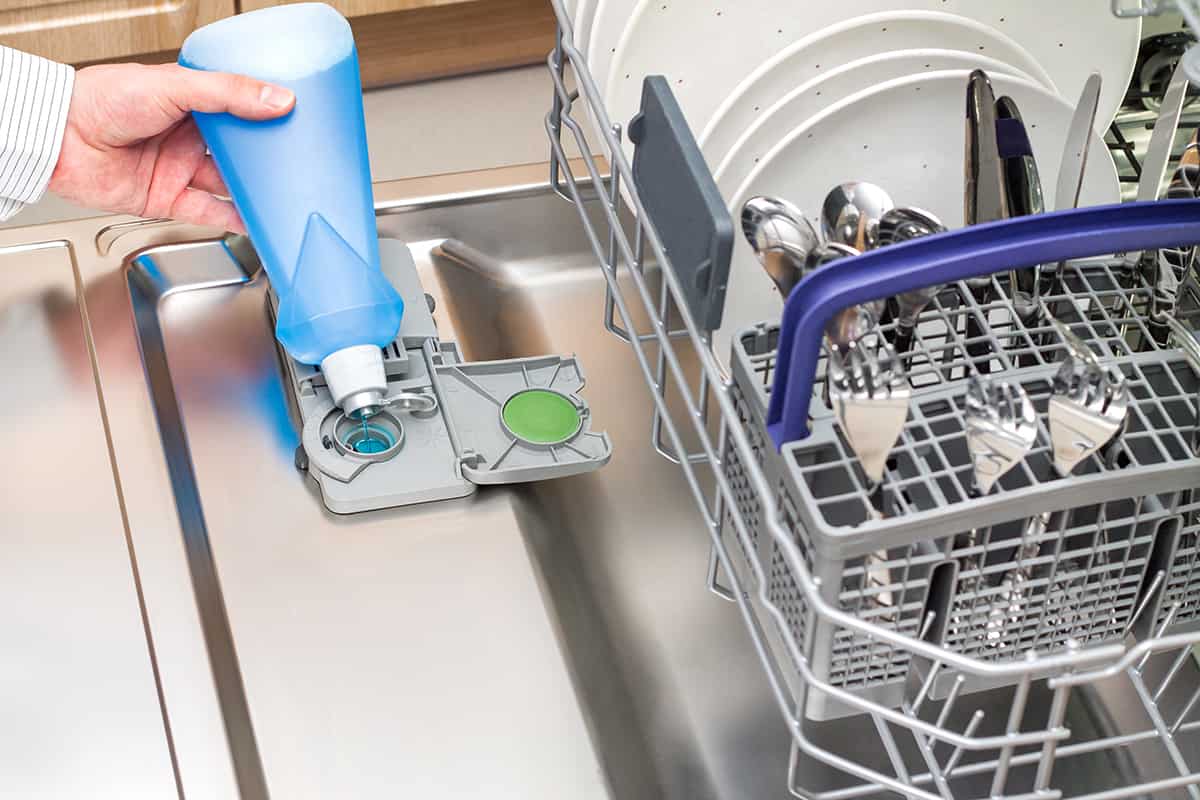Dishwashers are a lifesaver for those who want to free up time and energy spent on manual dishwashing. But for first-time users, the idea of loading dirty dishes into a machine and letting it do the work can be overwhelming. It’s not uncommon to hear stories of improperly loaded dishwashers, uneven cleaning, or mysterious smells.
Before running your dishwasher for the first time, here are a few things you should do:
- Turn off the power and water
- Read the manual cover to cover
- Choose and start an empty wash cycle
- Load the machine
- Add enough detergent
With a little knowledge and some best practices, you too can join the ranks of those who love their dishwashers and never look back.
How to Use a Dishwasher for the First Time
Before loading your dishwasher’s racks with dirty dishes, pressing a few buttons, and hoping for the best, there are a few key things you should do to ensure that the dishwasher runs as it’s supposed to.
1. Turn off the power and water
This step is critically important for those who are not going to install a dishwasher using their own two hands—i.e., almost all of us. If you’re waiting for a professional technician to come over and set up your dishwasher, you should turn off the power to your kitchen and shut the water valve.
Doing these two things will ensure that the technician won’t come across nasty shocks or splashes of water, which can get all over your kitchen floors. Of course, a good technician will double-check to ensure that the circuit to your kitchen and the water valve has been turned off, but it doesn’t hurt to give them a helping hand.
2. Read the manual cover to cover
Reading the manual cover to cover is like discovering hidden shortcuts and tricks to get the most out of your dishwasher. You’ll learn the ins and outs of loading dishes, what type of detergent to use, and how to troubleshoot any issues that may arise. Trust us, taking the time to read the manual is like finding a pot of gold at the end of a rainbow.
It’ll save you time and frustration in the long run and ensure that every dish is sparkling clean. So, grab a cup of coffee, find a cozy spot, and dive into the exciting world of dishwasher manual reading! You never know what gems of wisdom you’ll uncover.
3. Choose and start an empty wash cycle

Dishwashers come with multiple wash programs designed to serve different purposes and cater to various cleaning needs. From heavy-duty cycles for tough, baked-on food to gentle cycles for delicate glassware, there’s a program for everything.
The “normal” cycle is the most commonly used, perfect for everyday dishwashing. The “eco” cycle is energy-efficient and uses less water and energy for a more environmentally friendly option. The “quick wash” cycle is just what it sounds like, a fast and efficient option for lightly soiled dishes. Additionally, some dishwashers come with specialized cycles like “sanitize” or “steam clean,” providing extra cleaning power for those who want extra peace of mind.
The goal right now is to choose and start any wash program on an empty load. This will ensure that the hoses and pipes are connected as they’re supposed to and that the dishwasher is receiving enough water in the tub. If you notice any leaks, stop the dishwasher right away and fix any loose connections.
4. Load the machine
Loading a dishwasher might seem like a simple task, but it’s a delicate dance of strategy and placement. First things first, let’s bust some myths! Dishes don’t need to be facing a certain direction, and silverware doesn’t have to be arranged just so. But there are a few key tips that will help you get the best cleaning results.
Make sure large items, like pots and pans, are placed on the bottom rack to give smaller items room on the top. Leave a little space between items so water can circulate and reach every surface. And if you’re dealing with tough, baked-on food, give them a quick rinse before loading to prevent any potential cleaning issues.
If you read the manual, you should have a good idea of how to load dishes the right way. Just make sure you don’t overload your dishwasher, or you’ll end up with greasy plates and glasses!
5. Add enough detergent
The great thing about dishwasher detergent is that it doesn’t foam up like traditional dish soap. That means you can add as much detergent as you want without having to worry about the machine spewing froth and bubbles.
However, that doesn’t mean you should overfill the detergent dispenser, nor should you add too little. On average, 1 or 2 tablespoons of detergent is enough, but you should read the manual to figure out how much detergent to add based on your wash load.
Additional Tips for First-Time Dishwasher Owners

The steps provided above will give you a good idea of how to run your dishwasher for the first time. That said, there are a few things you should know in order to maintain proper dishwasher performance. Here’s a non-exhaustive list of dishwasher tips you should keep in mind.
1. Figure out how hard you water is
Hard water is water that has high levels of minerals like calcium and magnesium, which can leave behind deposits in your dishwasher. Mineral buildups can clog the dishwasher’s spray arms and decrease its cleaning performance, leading to spots and residue on dishes.
Additionally, hard water can also affect the efficiency of detergents and cause damage to the dishwasher over time. If you live in an area with hard water, it’s important to regularly clean and maintain your dishwasher to prevent any negative effects.
2. Use rinse aid
If your dishes come out splotchy, have unsightly powder spots on them, or aren’t drying, you should use a rinse aid. Rinse aid is a type of product that helps to reduce water spots and improve drying performance when used in a dishwasher. It works by lowering the surface tension of the water, allowing it to spread evenly over the dishes and dry quickly without leaving any streaks or spots.
Rinse aid also helps to prevent food particles from sticking to the dishes and makes it easier for the dishwasher to remove all the soap and suds. So, if you want your dishes to come out of the dishwasher spotless and dry, using a rinse aid is a smart move.
3. Keep a dishwasher maintenance checklist on hand
Like any appliance, dishwashers require regular maintenance to ensure optimal performance. This includes cleaning the interior, checking and cleaning the filters, and removing any built-up mineral deposits. It’s also important to check for any leaks, clogs, or worn parts and have them fixed promptly.
Regular maintenance will extend the life of your dishwasher, improve its cleaning efficiency, and prevent potential problems before they arise. Neglecting to maintain your dishwasher properly can lead to decreased performance, increased energy usage, and costly repairs down the road. If you don’t have a checklist, here you go!
4. Learn how to reset your dishwasher
Resetting a dishwasher can resolve issues such as errors in the display, water supply problems, or issues with the wash cycle. It’s a simple process that can be performed by following the manufacturer’s instructions.
Here are a few guides to help you figure out how to reset some common dishwashers.






